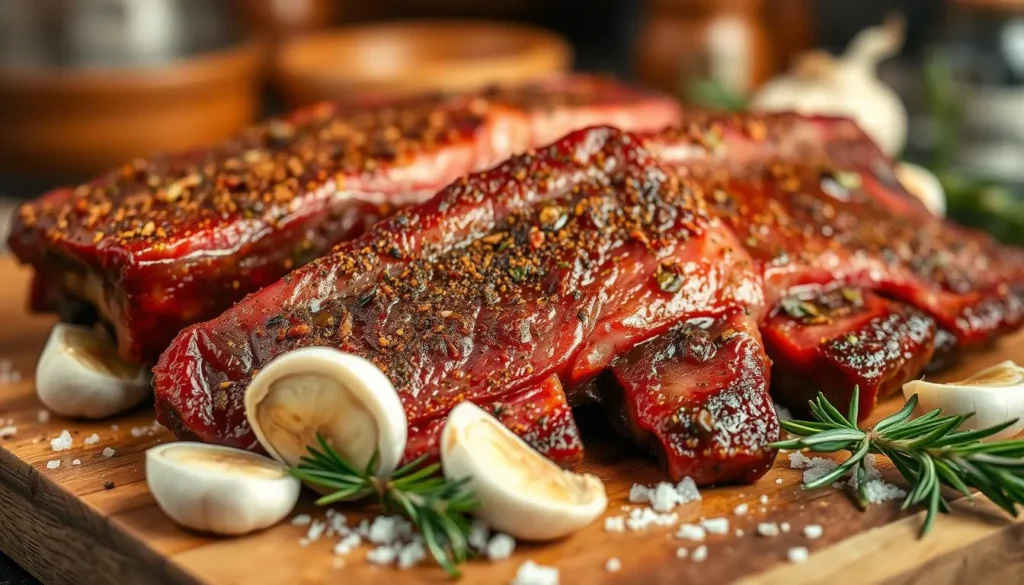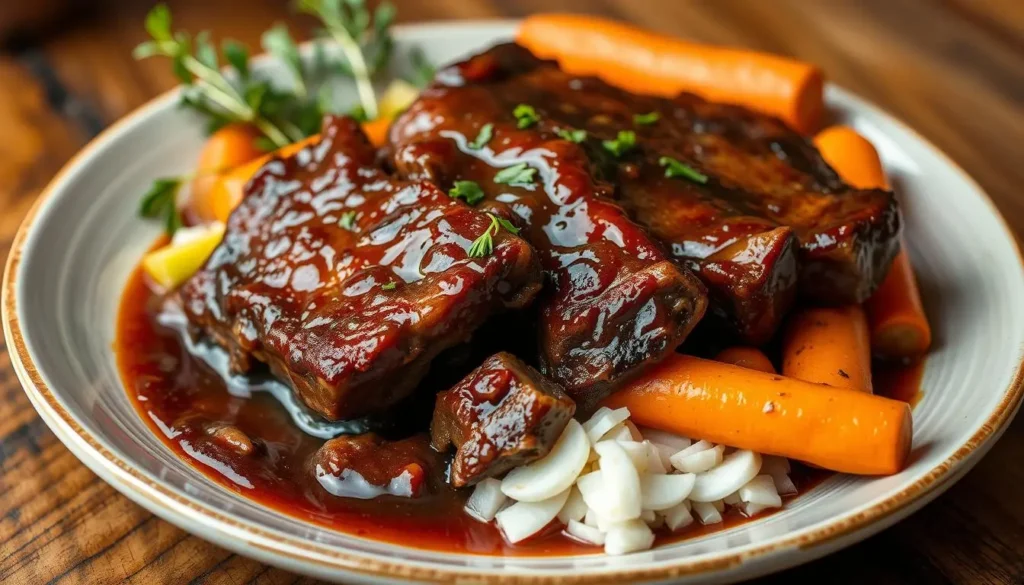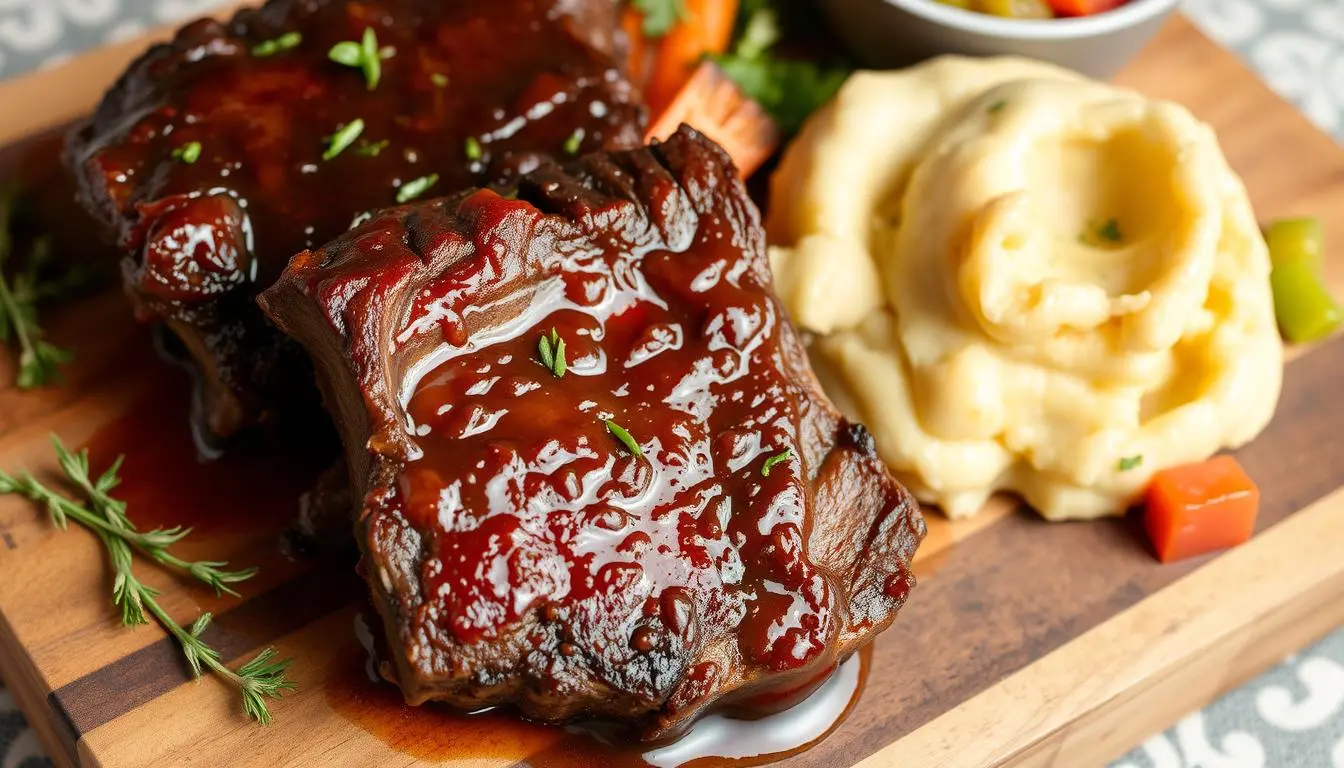- Difficulty Level: Intermediate
- Preparation Time: 20 minutes
- Cooking Time: 2.5–3.5 hours
- Rest Time: 10 minutes
Prepare for a gourmet experience that will delight your taste buds. You’ll learn how to make boneless beef short ribs that are tender and full of flavor. This guide will show you how to make a dish that rivals restaurant quality, all from your kitchen.
Whether you’re a beginner or an expert in the kitchen makes no difference. This article will give you the skills to make boneless beef short ribs that will wow everyone. You’ll be able to take your meals to the next level and enjoy the delicious taste of perfectly cooked boneless short ribs.
“Succulent boneless beef short ribs served on a rustic wooden cutting board with side dishes of mashed potatoes and seasonal vegetables, are perfectly cooked to a fall-apart soft texture, shimmering with a thick, glossy sauce, and adorned with fresh herbs. The scene is warm and welcoming.”
Key Takeaways
- Discover the key steps to preparing tender and flavorful boneless beef short ribs
- Learn how to select the right cut of short ribs and understand the different grades
- Master the essential equipment and cooking techniques for braising short ribs to perfection
- Explore a range of ingredients and seasoning options to enhance the natural flavors of the meat
- Understand the importance of searing, creating the perfect braising liquid, and monitoring the cooking process
Table of Contents
Step 1: Understand the Cut: Boneless Beef Short Ribs
Boneless beef short ribs are a special cut that deserves your attention. They are tender and flavorful, thanks to a unique butchering process. This process removes the bone, leaving you with a texture that just melts in your mouth. Knowing about the different grades and where to find these cuts can make your cooking better.
Different Grades of Short Ribs
Short ribs have different grades, each with its own traits. The most common are Prime and Choice grade short ribs. Prime ribs are the top quality, with lots of marbling for tenderness. Choice ribs offer great taste and texture at a lower price.
Prime vs Choice Short Rib Cuts
The main difference between Prime and Choice boneless short rib cuts is marbling. Prime ribs have a lot of intramuscular fat, making them very tender and flavorful. Choice ribs have less marbling but are still delicious, offering a great option for those who want quality beef short rib without the high cost.
Where to Source Quality Short Ribs
- Reputable butcher shops or specialty meat markets are great places to find boneless short ribs. They often get their meat directly from local farms, ensuring top quality.
- Online retailers that specialize in premium meats are also a good choice for short rib cuts. Look for those known for fresh, responsibly sourced products.
- Some grocery stores may carry boneless short ribs in their meat section. However, the quality and variety can vary.
Learning about boneless short ribs helps you choose the best cuts for your dishes. With the right knowledge and quality ingredients, you can make short ribs that are tender and full of flavor.
Step 2: Gather Essential Equipment
To master braised short ribs, you need more than just ingredients. The right tools are key for tender meat and rich flavors. Let’s look at the must-have equipment for perfect braised short ribs.
The Ideal Cooking Vessel
A heavy-duty, oven-safe Dutch oven or a large, deep skillet with a tight lid is best. These vessels spread heat evenly and keep moisture in, crucial for slow cooking.
Thermometers for Precise Control
Getting the temperature right is vital for braising short ribs. Use a digital meat thermometer to check the meat’s internal temperature. This ensures it’s cooked just right. An oven-safe thermometer also helps keep the oven at the perfect temperature.
Additional Kitchen Essentials
- Sharp chef’s knife for trimming and cutting the short ribs
- Tongs or forks for gently handling the tender meat
- Baking sheet or rimmed plate for searing the short ribs
- Ladle or skimmer for transferring the braised short ribs and sauce
- Cutting board for prepping the ingredients
With the right tools, you’re ready to make amazing braised short ribs. Your guests will be impressed.
| Equipment | Purpose |
|---|---|
| Dutch Oven or Heavy Skillet | Evenly distributes heat and retains moisture for braising |
| Digital Meat Thermometer | Ensures precise temperature control for doneness |
| Sharp Chef’s Knife | Enables efficient trimming and cutting of the short ribs |
| Tongs or Forks | Gently handles the tender braised short ribs |
| Baking Sheet or Rimmed Plate | Provides a surface for searing the short ribs |
| Ladle or Skimmer | Transfers the braised short ribs and sauce |
| Cutting Board | Prepares the ingredients for the braising process |
Step 3: Select the Ingredients
Starting with the right ingredients is key to making perfect boneless beef short ribs. Whether you’re an experienced cook or new to the kitchen, knowing the essential parts of this dish is crucial. It helps achieve that tender texture and rich flavor everyone loves.
Main Ingredients List
- Boneless beef short ribs
- Olive oil or vegetable oil for searing
- Salt and freshly ground black pepper
Aromatics and Seasonings
- Onions, diced
- Carrots, peeled and sliced
- Celery, diced
- Garlic cloves, minced
- Fresh thyme sprigs
- Bay leaves
- Dried herbs (such as rosemary, oregano, or Italian seasoning)
- Ground spices (such as cumin, chili powder, or paprika)
Braising Liquid Options
Choosing the right liquid is crucial for braising your boneless beef short ribs. You have several options:
| Liquid | Flavor Profile | Suggested Quantity |
|---|---|---|
| Red wine | Rich, bold, and complex | 1-2 cups |
| Beef broth or stock | Savory, meaty, and comforting | 2-3 cups |
| Tomato puree or crushed tomatoes | Tangy, acidic, and balanced | 1-2 cups |
| Beer or stout | Rich, malty, and slightly bitter | 1-2 cups |
By picking the right ingredients, aromatics, seasonings, and braising liquids, you can make an amazing boneless beef short ribs recipe. It will surely impress your family and friends.
Step 4: Prepare and Season the Ribs
Getting your beef short ribs ready is key to a tasty dish. First, trim off any extra fat from the boneless short ribs. Leave just a thin layer to baste the meat while it cooks. This makes the short rib recipe less greasy and more tender.
Then, it’s time to add flavor. You can use a dry rub or marinade. Dry rubs add lots of flavor, while marinades tenderize the meat and add more taste. Mix spices like garlic, onion, paprika, thyme, and rosemary to make a special seasoning for your beef short ribs.
- Season the boneless short ribs well with your chosen dry rub or marinade. Make sure to cover all sides.
- For the best taste, let the seasoned beef short ribs chill in the fridge for at least 30 minutes. Or for even more taste, for up to 24 hours.
- Let the short ribs reach room temperature before cooking. This helps them cook evenly.
By carefully preparing and seasoning your beef short ribs, you’ll make a dish that’s full of flavor. It’s a recipe that will make everyone want more.

A close-up image of beautifully seasoned boneless beef short ribs, showcasing a rich blend of spices and herbs, glistening with a savory marinade. The ribs are artfully arranged on a rustic wooden cutting board, surrounded by fresh garlic cloves, sprigs of rosemary, and scattered coarse sea salt, with a soft focus background of a warm kitchen ambiance.
Step 5: Sear the Ribs for Maximum Flavor
Getting the perfect sear on your beef short rib braise is key. It unlocks the meat’s natural richness and complexity. By controlling the temperature and using the right techniques, you can make a delicious crust. This crust seals in the juicy short rib meat.
Temperature Control Tips
The right temperature is crucial for searing. Your pan or oven should be very hot, between 400-500°F (200-260°C). This ensures the boneless beef short ribs recipe sears well and evenly. Don’t overcrowd the pan, as it can lower the temperature and cause steaming instead of searing.
Creating the Perfect Crust
To get a rich, caramelized crust, dry the short ribs with paper towels before seasoning. This helps the meat’s natural sugars brown and caramelize. Sear the ribs in small batches, letting each piece have enough time on the hot surface for 2-3 minutes per side.
Common Searing Mistakes to Avoid
- Overcrowding the pan: This lowers the temperature and leads to steaming instead of searing.
- Searing at too low a temperature: The meat won’t brown properly, and you’ll end up with a pale, flabby crust.
- Interrupting the searing process: Resist the urge to move the meat around; let it sear undisturbed for maximum caramelization.
- Searing for too long: This can cause the exterior to burn while the interior remains undercooked.
Mastering these searing techniques will help you make a beef short rib braise full of flavor and perfectly cooked.
Step 6: Create the Perfect Braising Liquid
Making the perfect braising liquid is crucial for amazing braised short ribs. The right mix of liquids, herbs, and aromatics makes a big difference. It turns your beef short rib braise into a flavorful dish.
Begin by picking the right liquids for your short rib recipe. Use beef or chicken stock, red wine, and maybe vinegar or tomato puree. This mix creates a rich, balanced braising liquid.
Add depth with aromatic ingredients. Thyme, rosemary, and bay leaves are great. Garlic, onions, and carrots add sweetness. Try spices like peppercorns, cloves, and star anise for a unique taste.
| Liquid Ingredients | Aromatic Ingredients |
|---|---|
| Beef or chicken stockRed wineVinegar or tomato puree | Fresh herbs (thyme, rosemary, bay leaves)Garlic, onions, carrotsSpices (peppercorns, cloves, star anise) |
Always taste and adjust the braising liquid. Add salt, pepper, or sweetness as needed. With the right mix, your braising liquid will make your braised short ribs tender and delicious.

A beautifully plated dish of fall-apart tender boneless beef short ribs, glistening with a rich, dark braising sauce, surrounded by vibrant vegetables like carrots and celery, garnished with fresh herbs, served on a rustic wooden table with warm, soft lighting highlighting the textures and colors.
Slow Cooking Temperature and Timing Guide
Getting the perfect slow-cooked short ribs needs careful attention to temperature and timing. Whether you’re making a boneless beef short ribs recipe or enjoying slow cooked short ribs, knowing how to cook them is crucial. It’s what brings out the full flavor and tenderness of this favorite meat.
Oven Temperature Settings
To get the best results, cook your beef short ribs in the oven at a low, steady temperature. The best range is between 275°F to 300°F. This slow cooking breaks down the connective tissues, making the meat tender and easy to fork.
Cooking Duration Guidelines
- For boneless beef short ribs, cook for 2.5 to 3.5 hours.
- For bone-in slow-cooked short ribs, cooking time can be 3 to 4 hours.
- The exact time can change based on the size and thickness of your short ribs.
Doneness Indicators
- The short ribs should be fork-tender, with the meat easily shredding away from the bone.
- An internal temperature of 200°F to 205°F is a good sign of perfectly cooked beef short ribs.
- When you gently poke the meat, it should feel soft and yielding. This means the connective tissues have fully broken down.
Remember, slow-cooking short ribs requires patience. Avoid opening the oven door too frequently. This can mess with the steady temperature and make cooking take longer.
Troubleshooting Common Short Rib Problems
Cooking tender, flavorful short ribs can be a challenge. However, you can overcome common problems if you know the right techniques. If your short ribs turn out tough and dry, try adjusting your cooking time and temperature.
Beef short ribs that are tough or stringy? Try braising them for an hour or two longer. This ensures they become tender and fall-off-the-bone. On the other hand, if your boneless short ribs are dry, lower the oven temperature. Increase the cooking time to break down connective tissues, adding moisture and flavor.
Want a more robust flavor in your short ribs? Add aromatic vegetables, herbs, and a bit of red wine or beef stock to the braising liquid. This will enhance the taste and aroma of your dish. With a bit of experimentation, you’ll soon be making short ribs that everyone will love.
FAQ
What are the key differences between boneless and bone-in beef short ribs?
Boneless short ribs are easier to prepare and portion. They have a consistent texture. Bone-in ribs offer more flavor from the marrow and are great for braising.
How can I choose boneless short ribs of the highest caliber?
Seek out cuts with a deep red color and good marbling. Avoid dry or tough pieces. Choose from a reputable butcher or grocery store for freshness and quality.
What equipment do I need for braising boneless short ribs?
You’ll need a Dutch oven or large pot with a tight lid. A meat thermometer is crucial for checking the ribs’ temperature. A sharp knife and cutting board are also necessary for preparation.
What ingredients are typically used in a boneless short rib recipe?
The recipe includes short ribs, onions, garlic, and herbs. Beef broth, red wine, or a mix of both are common braising liquids. Seasonings like salt, pepper, and spices add flavor.
How should I prepare and season the boneless short ribs before cooking?
Trim excess fat and connective tissue from the ribs. After patting them dry, use a marinade or dry rub to season. Let the seasoned ribs rest at room temperature for 30 minutes before searing.
What’s the best way to sear boneless short ribs for maximum flavor?
Work in small batches and keep the heat high. Pat the ribs dry before adding them to a hot pan. Don’t move the ribs too much to get a rich, caramelized crust.
How do I create the ideal braising liquid for boneless short ribs?
The braising liquid is key. Mix beef broth, red wine, and aromatics like onions and garlic. You can also add tomato paste or Worcestershire sauce for extra flavor. The goal is a rich, complex liquid that tenderizes the meat.
What temperature and cooking time do I need for perfectly tender boneless short ribs?
Braise the ribs at 300°F (150°C) for 2-3 hours. They should be fork-tender and falling off the bone. Check the internal temperature with a meat thermometer, aiming for 205°F (96°C).
How can I troubleshoot any issues with my boneless short rib dish?
If the ribs are tough or dry, you’ve likely overcooked them. Adjust the temperature and time. For less flavor, check your seasoning and braising liquid. If the sauce is too thin, reduce it on the stovetop or thicken with a roux. With the right techniques, you can achieve tender and flavorful ribs every time.
Explore Our Delicious Recipe Categories
Craving more mouthwatering meals? Check out these flavorful recipe categories for every taste and occasion:
- Chicken: Explore a world of flavors with our chicken recipes. From grilled delights to comforting one-pot meals, discover versatile dishes for every occasion.
- Beef: Savor the richness of beef in hearty stews, juicy roasts, and quick recipes. Whether grilling or slow-cooking, find your favorite way to enjoy beef.
- Seafood: Dive into fresh and flavorful seafood dishes. From grilled fish to creamy stews, these recipes bring the ocean’s best to your table.
- Meaty Pasta: Perfect for busy days, these hearty pasta dishes are ready in no time. Explore quick recipes featuring beef, chicken, or seafood — all easy to make and ready in under 30 minutes.
Helpful Resources on Storage and Nutrition
Here are some helpful resources for health advice and food storage.
- Food Storage and Freezing Tips: The USDA Food Safety Guide offers detailed tips. Epicurious also has freezing advice to prevent food waste.
- Nutrition Information: MyFitnessPal and CalorieKing offer easy ways to check calorie counts.
- Health and Wellness Guides: Balanced indulgence is key. The Mayo Clinic offers guides on healthy eating. Harvard Health also has balanced nutrition tips.
